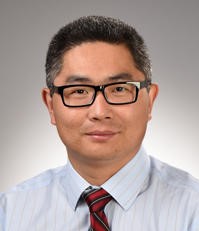In the Harry Potter universe, Harry Potter regrew a bone simply by drinking a magic potion. Researchers at the University of Iowa College of Dentistry are working to make this fantasy a reality—not with magic but with novel tissue engineering strategies and cutting-edge science.

Hongli Sun, associate professor in the Department of Oral and Maxillofacial Surgery and the Iowa Institute for Oral Health Research, is one of several faculty members at the college leading the charge to develop novel bone regeneration strategies.
Typically, when bones or joints are seriously damaged, such as in multiple or complex fractures or in bones that are seriously compromised by age, disease, infection, or injury, the most common treatment is a bone-graft using one’s own bone material. A less invasive and potentially more effective approach is to harness a body’s own bodily repair processes to quickly and efficiently repair and regenerate bone.
Sun’s team is researching more effective ways to use the body’s own internal repair processes by tailoring a specific bone regeneration strategy to the specific cause(s) of bone damage. There are two major areas where his team is making great strides.
In the first area, emerging research uses deferoxamine, a drug that treats iron poisoning, to activate the hypoxia-induced factor-1α, which in turn promotes angiogenesis and bone regeneration. The two biggest obstacles to this line of research has been safety concerns and complicating factors, such as chronic inflammation, which are common among older individuals.
Sun’s team is addressing both obstacles. Sun’s team uses a small molecule, phenamil, to reduce inflammation and promote endogenous bone regeneration. To address safety concerns, the research team has engineered a novel nanomaterial scaffold that mimics the bone collagen structure and delivers deferoxamine and phenamil locally and controllably.
“The drug themselves are not new and people have been using them, but we are developing a new method for controlled release of the drugs that can be delivered at a specific location,” Sun explained.
These two innovations could pave the way for treatments to rejuvenate and repair significant bone damage, even for older adults. Sun and his team were recently awarded a five-year National Institutes of Health grant totaling over $1.7 million to support this research project
In a second area, Sun and his team are developing a specific bone regeneration strategy tailored to the specific needs associated with periodontitis-induced bone and tooth loss. In particular, the strategy treats the bacteria that causes periodontitis while continuously and effectively directing the body’s own repair processes to the site of the damage.
Although Sun has only been at the College of Dentistry since 2018, he has had remarkable success in developing his own research and securing grant funding for his projects.
From developmental biologists, like Brad Amendt, to research design and biostatistical support from Xian Jin Xie, to mechanics support from the College of Engineering, to clinical expertise from oral surgeons and periodontists, Sun has found a wide-range of collaborators that ultimately makes his work better.
“For any major research like this, we really need a well-rounded team, with a lot of different experts from different areas,” Sun explained, “and I came to Iowa because I knew I would get strong support that from other researchers, support staff, and the administration,” he added.
With researchers like Sun and his team on the case, it’s only a matter of time before we are making the fantasy of regrowing bone tissue a reality.